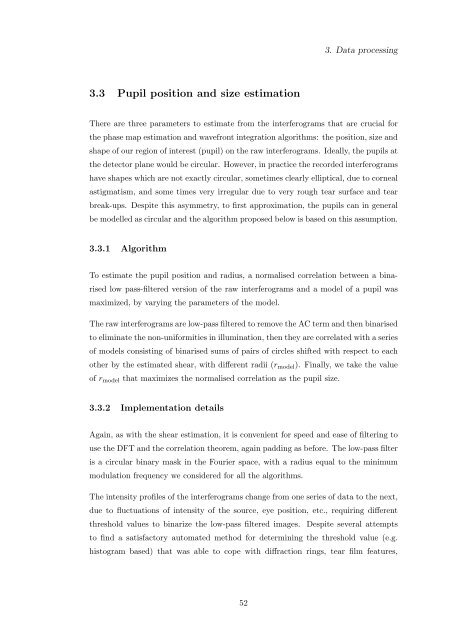Alfredo Dubra's PhD thesis - Imperial College London
Alfredo Dubra's PhD thesis - Imperial College London
Alfredo Dubra's PhD thesis - Imperial College London
You also want an ePaper? Increase the reach of your titles
YUMPU automatically turns print PDFs into web optimized ePapers that Google loves.
3. Data processing<br />
3.3 Pupil position and size estimation<br />
There are three parameters to estimate from the interferograms that are crucial for<br />
the phase map estimation and wavefront integration algorithms: the position, size and<br />
shape of our region of interest (pupil) on the raw interferograms. Ideally, the pupils at<br />
the detector plane would be circular. However, in practice the recorded interferograms<br />
have shapes which are not exactly circular, sometimes clearly elliptical, due to corneal<br />
astigmatism, and some times very irregular due to very rough tear surface and tear<br />
break-ups. Despite this asymmetry, to first approximation, the pupils can in general<br />
be modelled as circular and the algorithm proposed below is based on this assumption.<br />
3.3.1 Algorithm<br />
To estimate the pupil position and radius, a normalised correlation between a binarised<br />
low pass-filtered version of the raw interferograms and a model of a pupil was<br />
maximized, by varying the parameters of the model.<br />
The raw interferograms are low-pass filtered to remove the AC term and then binarised<br />
to eliminate the non-uniformities in illumination, then they are correlated with a series<br />
of models consisting of binarised sums of pairs of circles shifted with respect to each<br />
other by the estimated shear, with different radii (r model ). Finally, we take the value<br />
of r model that maximizes the normalised correlation as the pupil size.<br />
3.3.2 Implementation details<br />
Again, as with the shear estimation, it is convenient for speed and ease of filtering to<br />
use the DFT and the correlation theorem, again padding as before. The low-pass filter<br />
is a circular binary mask in the Fourier space, with a radius equal to the minimum<br />
modulation frequency we considered for all the algorithms.<br />
The intensity profiles of the interferograms change from one series of data to the next,<br />
due to fluctuations of intensity of the source, eye position, etc., requiring different<br />
threshold values to binarize the low-pass filtered images. Despite several attempts<br />
to find a satisfactory automated method for determining the threshold value (e.g.<br />
histogram based) that was able to cope with diffraction rings, tear film features,<br />
52

















